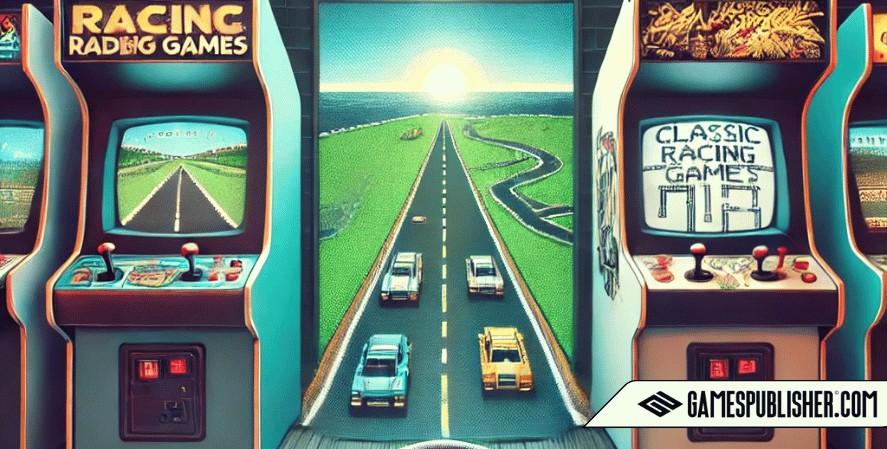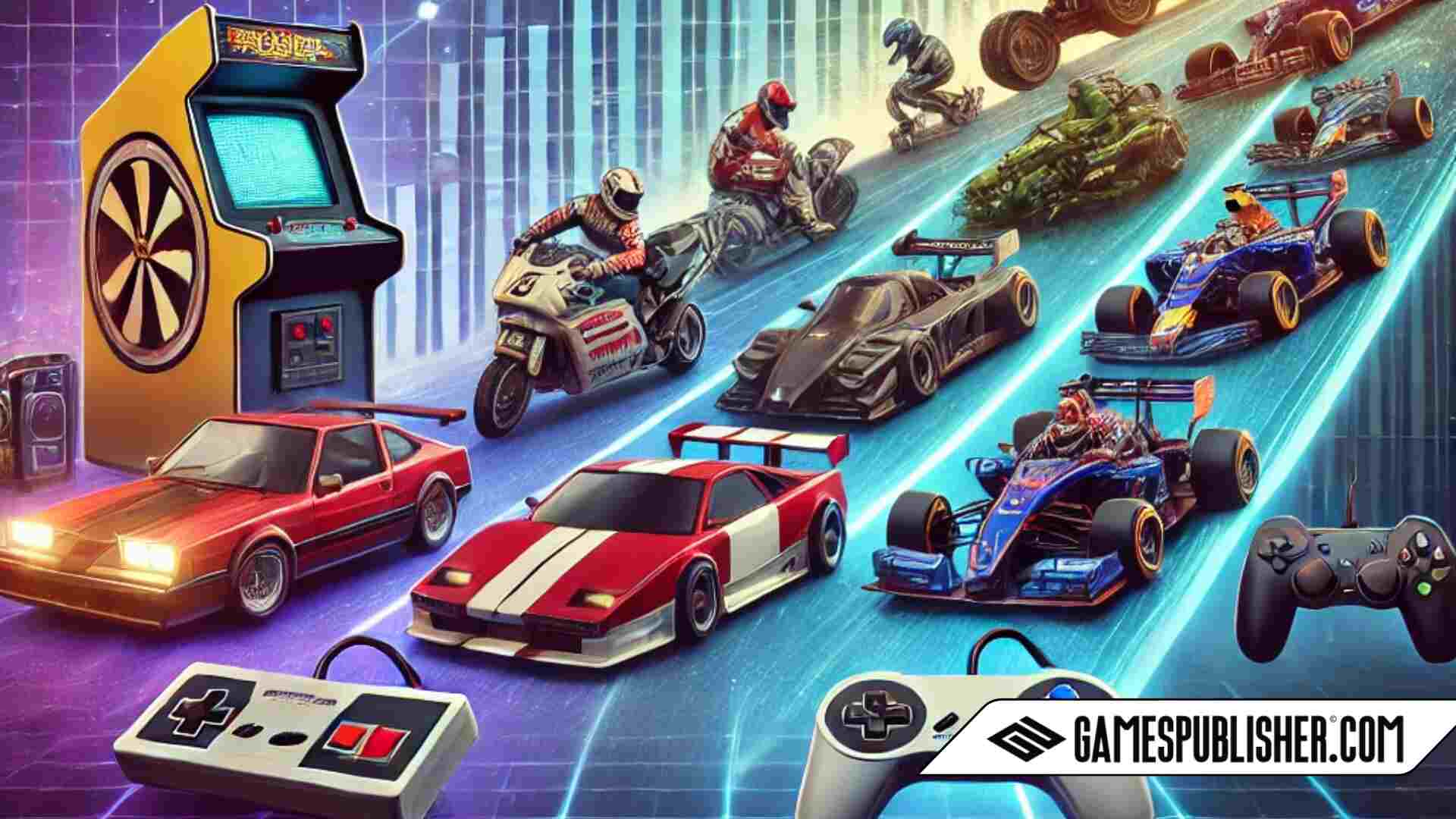The origins of sports and racing video games are fascinating, tracing back to the early days of the gaming industry when developers experimented with new forms of interactive entertainment. These two genres sports and racing have grown to become some of the most popular and enduring in the gaming world.
This article, brought to you by Gamespublisher.com a top platform for game development insights, publishing tips, and video game trends takes a look at the origins of sports and racing video games. By understanding the history of these genres, we can see what made them so successful and get ideas for the future.
1. The Early Days of Video Games

The Birth of Video Games (1950s – 1970s)
The first video games started as experiments in universities and military labs. They were not for entertainment; instead, they showed off new technology.
- “Spacewar!” (1962): This game was one of the first interactive video games. While it wasn’t a sports or racing game, it showed that games could be fun and exciting.
- Table Tennis for Two (1958): This simple game was a lot like table tennis. It’s often seen as an early version of a sports video game because it involved competition between two players.
Why These Games Matter
These early games showed that video games could be a form of entertainment. They opened the door for game developers to create all kinds of new games, including sports and racing games.
2. The Start of Sports Video Games
Sports Games as Simulations
Sports games were a natural fit for video games. People already loved sports, so it made sense to create games where players could compete in virtual sports.
- Pong (1972): Created by Atari, “Pong” is often seen as the first successful sports game. It was a simple tennis game that became incredibly popular in arcades and helped make video games mainstream.
- Growth of Early Sports Titles: After “Pong,” Atari created games like “Video Olympics” and “Football.” These games introduced more sports into the gaming world.
Key Developers and Companies in Sports Games
- Atari: Atari was a pioneer in the early days of sports games. They showed that people loved competing in virtual sports.
- Nintendo: Nintendo entered the sports game scene in the 1980s with titles like “Tennis” and “Golf” for the NES, bringing sports games to home consoles.
- EA Sports: In the 1990s, EA Sports launched its famous “Madden NFL” series. This game set a new standard for sports games, focusing on realism and strategy.
3. How Racing Video Games Began

The First Racing Games (1970s-1980s)
Racing games were also popular in arcades, offering the thrill of speed and competition.
- Gran Trak 10 (1974): This was one of the first arcade racing games. It had simple controls and a top-down view, introducing players to basic racing mechanics.
- Night Driver (1976): Atari developed this game with a first-person perspective, which made players feel like they were actually driving.
- Pole Position (1982): Namco’s “Pole Position” was a big hit. It introduced checkpoints, laps, and complex tracks, which became the standard for future racing games.
Important Studios in Racing Games
- Namco: Namco’s work on “Pole Position” was groundbreaking. It showed that racing games could be more complex and challenging.
- SEGA: SEGA’s game “OutRun” (1986) became famous for its colorful graphics and fun driving experience. It also used real car brands, which excited car fans.
- Nintendo: Nintendo created “Super Mario Kart” (1992), starting the kart-racing subgenre. This style of racing game was fun for all ages and became a huge success.
4. Moving Toward Realism in Sports and Racing Games
Technology Makes Games More Realistic
In the 1980s and 1990s, technology got better, allowing for more realistic sports and racing games.
- Realistic Sports Games: With new technology, games like “FIFA” and “NBA 2K” began using motion capture to make players move more like real athletes.
- Racing Simulations: Games like “Gran Turismo” (1997) and “Forza Motorsport” (2005) moved away from arcade racing. They offered realistic driving experiences and detailed car customization, which appealed to car enthusiasts.
5. The Cultural Impact of Sports and Racing Games

Sports Games as Global Phenomena
Sports games like “FIFA” and “Madden NFL” became popular worldwide. They are more than just games—they bring sports fans together and even influence real sports culture.
- Esports: Sports games like “FIFA” and hybrid games like “Rocket League” have become part of esports, where players compete in tournaments watched by thousands of fans.
- Racing Games and Car Culture: Racing games like “Need for Speed” and “Gran Turismo” have inspired car culture. Many players love customizing their cars in games, and some even carry that passion into real life.
6. New Subgenres and Game Styles
Kart Racing
Games like “Super Mario Kart” started the kart racing subgenre, which is all about fun and friendly competition. Other games like “Crash Team Racing” followed this style, attracting players of all ages.
Street Racing and Open-World Racing
The “Need for Speed” series brought street racing to video games, adding themes of car modification and urban landscapes. Open-world games like “Burnout” added freedom for players to explore and race.
Hybrid Games and Crossovers
Some games mix genres. For example, “Rocket League” combines soccer and racing, creating a unique experience that’s both a sports and racing game.
7. Modern Trends and the Future
VR in Racing Games
Virtual reality (VR) is becoming popular in racing games, creating an immersive experience. Games like “Gran Turismo 7” now offer VR modes, making players feel like they’re really driving.
AI in Sports Games
Artificial Intelligence (AI) is making sports games smarter. Games like “FIFA” use AI to create more realistic player behaviors and strategies, making each match feel unique.
Live Services in Sports Games
Many sports games now include live updates and online content. For example, “FIFA Ultimate Team” lets players collect and trade virtual player cards. This keeps the game fresh and engaging all year round.
Conclusion
Understanding the history of sports and racing video games helps us appreciate where they came from and where they’re going. The early developers and video game publishers who created these genres laid the foundation for today’s gaming world.
For modern game developers, knowing these roots can be a source of inspiration. As technology continues to advance, the future of sports and racing games looks exciting, with more realistic graphics, smarter AI, and immersive VR experiences on the horizon.
Loading survey...

